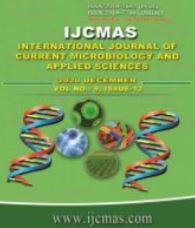


 National Academy of Agricultural Sciences (NAAS)
National Academy of Agricultural Sciences (NAAS)

|
PRINT ISSN : 2319-7692
Online ISSN : 2319-7706 Issues : 12 per year Publisher : Excellent Publishers Email : editorijcmas@gmail.com / submit@ijcmas.com Editor-in-chief: Dr.M.Prakash Index Copernicus ICV 2018: 95.39 NAAS RATING 2020: 5.38 |
The effective selection of parents and further utilization for hybridization programme depends on the knowledge about genetic makeup of experimental material. In order to assess the genetic diversity among the seed parents and restorers, a study was conducted to identify the potential parents and variables for further selection. A total of 59 parental lines which includes maintainer and restorer lines of pearl millet were characterized based on quantitative characters. Considerable variation was observed in all the studied characters. Genetic divergence analysis was carried out based on multivariate analysis using Mahalanobis’s D2 statistics and PCA. In D2 analysis, the experimental materials were grouped into five major clusters. Cluster I having the highest number of lines followed by cluster II due to common ancestry of parental lines. The highest inter cluster distance was observed between cluster I and V followed by cluster III and IV. Based on cluster mean performance the line belonging to cluster V recorded high mean performance for yield attributing quantitative characters like spike length , spike girth, leaf blade length, leaf blade width, 1000 seed weight and dry fodder yield and Cluster IV showed the highest value for number of productive tillers/plant and plant height and days to 50 percent flowering. Selection of lines belongs to this clusters will provide high yielding hybrids in breeding programme. The principal component analysis was used for data reduction method and it generate different principal components. The first three PC’s explained 63.8% of total variability of among the parental lines. Based on factor loading of three PC’s explained that the traits viz., days to 50 percent flowering, leaf blade width and spike girth act as a good selection indices which shows positive loading towards genetic diversity. The parental lines viz., PT 6697, PT 6059, PT 6347, PT 6069, CBMS 185B/3-2, CBMS 134B/5-3, CBMS 135B/1-3, CBMS 173B/4-5 shows diverse in both D2 and PCA analysis and It revealed that utilization of this parental lines for hybridization programme will yield positive results.
 |
 |
 |
 |
 |